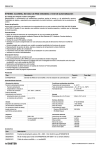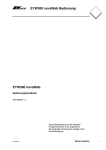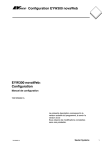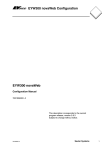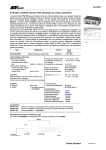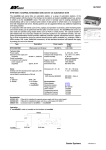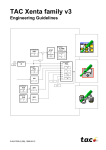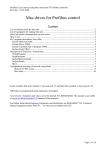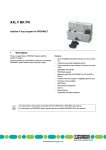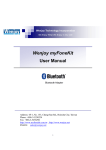Download EYW300 novaWeb Operation
Transcript
EYW300 novaWeb Operation EYW300 novaWeb User's Manual 7001049003 A This description corresponds to the current program release, version 2.8.3. Changes are taking place constantly, without prior notification. 7001049003 A Sauter Systems 1 EYW300 novaWeb Operation 2 7001049003 A Sauter Systems EYW300 novaWeb Operation 0 Table of contents 1 Introduction ...............................................................................................................5 2 novaWeb documentation .........................................................................................7 3 Requirements ............................................................................................................9 4 Layout and navigation............................................................................................11 4.1 4.2 4.3 4.4 5 Header (top) ......................................................................................................12 Navigation (left) .................................................................................................12 Main (right) ........................................................................................................12 Navigation with smartphones ............................................................................13 Login/logout ............................................................................................................15 5.1 5.2 5.3 5.4 Version information ...........................................................................................15 Your name.........................................................................................................15 User level ..........................................................................................................16 Password...........................................................................................................16 6 Control loops ..........................................................................................................17 7 Installations.............................................................................................................19 7.1 Installation view .................................................................................................19 7.2 History ...............................................................................................................23 7.3 User interactions ...............................................................................................24 7.3.1 Push-button commands ...........................................................................25 7.3.2 Reset runtime...........................................................................................25 7.3.3 Changing the time schedules...................................................................26 7.3.4 Command.................................................................................................27 7.3.5 Change of values .....................................................................................27 7.4 Additional links ..................................................................................................27 7.4.1 Functional description ..............................................................................27 7.4.2 Schematics...............................................................................................28 7.5 Service view ......................................................................................................29 7.6 System maintenance view.................................................................................30 8 Alarms......................................................................................................................31 8.1 8.2 8.3 8.4 8.5 9 Indication of all active/all generated alarms.......................................................31 Alarm priorities ..................................................................................................31 Acknowledging ..................................................................................................32 System errors ....................................................................................................32 Additional information on alarms .......................................................................32 Events ......................................................................................................................33 10 Settings....................................................................................................................35 10.1 Guest access.....................................................................................................35 10.2 User access.......................................................................................................35 7001049003 A Sauter Systems 3 EYW300 novaWeb Operation 0 Table of contents 10.3 Service access .................................................................................................. 35 10.4 System maintenance access ............................................................................ 35 10.5 Data acquisition ................................................................................................ 36 10.5.1 Typical data acquisition table................................................................... 36 11 Automatic update ................................................................................................... 37 12 E-mail messages .................................................................................................... 39 12.1 Alarm and event notification via e-mail ............................................................. 39 12.1.1 Settings and alarm................................................................................... 39 12.1.2 Header ..................................................................................................... 42 12.1.3 Content .................................................................................................... 43 12.1.4 Adapting alarm messages ....................................................................... 43 12.2 Data acquisition via e-mail ................................................................................ 44 12.2.1 Settings and data acquisition................................................................... 44 12.2.2 Header ..................................................................................................... 44 12.2.2.1 Contents and attachment ....................................................................45 12.2.2.2 K type log.............................................................................................45 12.2.2.3 L type log .............................................................................................45 12.2.2.4 Saving..................................................................................................45 12.3 Processing of data acquisition files ................................................................... 46 12.3.1 Standard spreadsheet programs ............................................................. 46 12.3.2 MS Excel.................................................................................................. 46 13 Hints ........................................................................................................................ 49 13.1 Transferring alarms and historical data............................................................. 49 13.2 Security ............................................................................................................. 49 14 Tips and tricks ........................................................................................................ 51 14.1 'Reload'/'Refresh' button after user entries ....................................................... 51 14.2 Cache................................................................................................................ 51 14.3 Memory settings................................................................................................ 51 15 Appendix ................................................................................................................. 53 15.1 Cookies ............................................................................................................. 53 15.1.1 Cookie Settings for Internet Explorer....................................................... 53 15.1.2 Cookie settings for Mozilla Firefox........................................................... 55 15.1.3 Cookie settings for SE P910i ................................................................... 57 15.2 JavaScript ......................................................................................................... 57 15.3 Language settings............................................................................................. 57 15.4 Connection........................................................................................................ 58 15.4.1 Direct TCP/IP connection ........................................................................ 58 15.4.2 Dial-up (PPP) connection ........................................................................ 59 16 Abbreviations and terminology............................................................................. 67 4 7001049003 A Sauter Systems EYW300 novaWeb Operation 1 Introduction 1 Introduction novaWeb is an embedded web server that allows to visualise your installation via a standard web browser. Special attention has been put on a light weight interface (pure HTML, without ActiveX, Java,..) to allow for fast access even with very simple devices like smartphones. According to your login level, you can visualise any states or measurements, modify setpoints and commands or modify any settings. Alarms and events (like the change of values) can be sent to e-mail recipients. Furthermore, novaWeb can send out an e-mail to transfer historic values for billing or archiving. Thanks to the remote access, you can easily optimise your installation without wasting time through having to go on site. This manual describes the user interactions via web browser (Internet Explorer or Mozilla Firefox) and via the standard web browser of a Symbian smartphone (SonyEricsson P910i). Since the web server is based on accepted internet standards (HTML), any web browser complying to these standards should work accordingly. Testing, however, has been limited to these programs. Since it is intended for a standard user working on an already-configured installation, the user manual does not describe any configuration or programming issues. For these, please refer to the appropriate manual (see also novaWeb Documentation). 7001049003 A Sauter Systems 5 EYW300 novaWeb Operation 1 6 Introduction 7001049003 A Sauter Systems EYW300 novaWeb Operation 2 novaWeb documentation 2 novaWeb documentation According to the needs of the different users, the documentation for novaWeb has been split up into several manuals: Order Number 7001049 Title User Manual Target Audience End User Content Standard user operations like 7001057 7001056 Connecting to the site Visualisation E-mail reception Quick Start Guide Project or Programming Engineer Basic Connection Set-up Configuration Manual Connections Project Engineer Power Supply, novaNet & Ethernet TCP/IP Dial-up Advanced Features 7001050 7001049003 A Programming Manual Programming Engineer (Case Builder and Engine) Firewall Settings Dynamic DNS E-mail Settings Programming Content of HTML pages Card code rules House address structure Extensions Sauter Systems 7 EYW300 novaWeb Operation 2 novaWeb documentation Apart from these manuals, several other sources of information are available via the Sauter intranet: 8 Product Data Sheet PDS Product Information PI FAQ (Frequently Asked Questions) 7001049003 A Sauter Systems EYW300 novaWeb Operation 3 Requirements 3 Requirements A standard HTML 4.01-compliant web browser which supports frame-based pages is needed for optimal access to novaWeb pages. For standard Windows PCs, we recommend the current versions of Internet Explorer V6.0 (or higher) or Mozilla Firefox V1.7 (or higher). The access via a smartphone or a PDA is also possible. Due to the relative small size of the screen of these devices, we recommend that you use a special entry page without frames or bookmark the content page as one of your favourites (for more information, see 4.4). 7001049003 A Sauter Systems 9 EYW300 novaWeb Operation 3 10 Requirements 7001049003 A Sauter Systems EYW300 novaWeb Operation 4 Layout and navigation 4 Layout and navigation All standard (HTML 4.01 compliant) internet browsers will show a novaWeb page subdivided into three frames: Header Navigation Main Window The header shows the site's name and some pictures and links. The contents of the main window depend on the selection in the navigation frame on the left. If any of these three frames cannot be displayed entirely, scrollbars will appear and give you the possibility of navigating to the location you need. 7001049003 A Sauter Systems 11 EYW300 novaWeb Operation 4 Layout and navigation 4.1 Header (top) Beside the site name is the Sauter logo, which normally contains a link to your Sauter support page. Additionally, it may contain further logos and links to some home pages of the installation owner, maintenance company etc. 4.2 Navigation (left) Navigation Link Display in Main Frame Login/Logout Login and logout Control Loops Overview of control loops Air Handling Unit 01 Installation view: - Number of installations according to your site - Access to function descriptions and schemas Air Handling Unit 02 Chiller Basement Heating Alarms Alarm list Events Event logs Settings Configuration pages Automatic update How often the data in the main frame are updated. The links to Login/Logout, Control Loops, Alarms, Events and Automatic Update are shown for each user. Between Control Loops and Alarms is a list of configured installations (e.g. Air Handling Unit 01, Chiller Basement,..) depending on your specific installation. The Settings page is shown only for users with the appropriate user rights. 4.3 Main (right) Depending on the selection in the navigation frame, you will see the login/logout, the Control Loops, any installation, ...page as indicated above. 12 7001049003 A Sauter Systems EYW300 novaWeb Operation 4 Layout and navigation 4.4 Navigation with smartphones Some smartphone browsers (e.g. standard browser of SonyEricsson P9010i) cannot show all frames at the same time. In this case, you have to select which one of the three frames should be shown. Select 'content' to show the navigation frame. From here, you can select the page you want to see. The first time you select any page, the login page will appear. If you selected a different page to the login page, you have to reload the page after login to get to the selected page. To switch to another page, you have to go back to the navigation frame. For easier access, you can bookmark the navigation page (content) or even specify it as your home. Alternatively, you could select the 'noframe.html' page (e.g. http://embweb02.ch.sauterbc.com/noframe.html). In this case, only one menu will be shown, but you still have to go back to the start page before going on to a different page. 7001049003 A Sauter Systems 13 EYW300 novaWeb Operation 4 14 Layout and navigation 7001049003 A Sauter Systems EYW300 novaWeb Operation 5 Login/logout 5 Login/logout Go to the Login page: Enter your user name (typically your e-mail address), Select your user level Enter your password and hit the Login button. Login novaWeb v2.8.3 After login, you will go straight to the alarm page as primary information. To log off, just go back to the login page once again (select Login/Log off in the navigator frame on the left). 5.1 Version information During login, you always get the information about the installed version of your novaWeb station (e.g. novaWeb v2.8.3 means version 2.8.3). 5.2 Your name User name/e-mail address e.g. [email protected] 7001049003 A Sauter Systems 15 EYW300 novaWeb Operation 5 Login/logout 5.3 User level Guest As a guest, no password is required. Guest are allowed to view only the main values of control loops, installations, alarms and events without being able to modify anything. User A standard user account gives you access to all guest activities plus normal user operations like the acknowledging of alarms, the changing of setpoints and so on. Service On top of the standard user rights, the service user has access to the service list, which allows him to modify some control loop parameters. System maintenance Only a System Maintenance user has access to the system maintenance list and is allowed to modify the whole configuration (settings page), in addition to the other rights. 5.4 Password You have to enter the correct password for your user level. The password will be provided from your system engineer and cannot be changed by you. 16 7001049003 A Sauter Systems EYW300 novaWeb Operation 6 Control loops 6 Control loops An overview of the control loops in the installation can be found under the 'Control Loops' link in the navigation window. It always shows the actual (measured) value, the corresponding setpoint and the difference between them. To obtain the overview, the installation should have a structure for the house addresses that permits an optimum representation of the system using novaWeb. The requirements for such a structure for the house addresses are described in the programming manual for novaWeb EYW300 (document 7001050). Control Loops Actual Setpoint Diff Supply Air Temp 32.6 °C 34 °C -1.4 °C Cooling Water Temp 16.1 °C 16 °C 0.1 °C To facilitate the handling of your Control Loops the deviation (or difference) is shown with a green background for very small deviations, olive for small deviations and yellow for large deviations. Like this the user can see very fast if he needs to act on any of them. The distinction between very small, small and large deviation is made regardless of the type of control loop or the setpoint's unit (e.g. °C, Pa, rh).: Setpoint > 10 units Setpoint • 10 units Deviation < 5% of setpoint deviation < 0.5 5 % of setpoint 0.5 Small deviation deviation < 10 % of setpoint deviation < 1 Border between small and large 10 % of setpoint 1 Large deviation deviation > 10% of setpoint deviation > 1 Very small deviation Border between very small and small 7001049003 A Sauter Systems 17 EYW300 novaWeb Operation 6 18 Control loops 7001049003 A Sauter Systems EYW300 novaWeb Operation 7 Installations 7 Installations If you select any installation in the navigation bar per default the standard installation view will be shown. It consists of the installation view itself plus some additional links according to your site. 7.1 Installation view In the installation view you get an overview of your installation structured according to the following sections: Device Control Loops Control loop 1 Control loop 2 Outputs Monitoring and Alarm Device o Displays the main devices, like fans or pumps, together with feedback signals, commands and alarm condition Control Loops o Outputs o Shows all data points belonging to a control loop grouped together as such N.B.: The representation of the control loop necessitates a structure for the house address that complies with certain naming conventions, which are described in the programming manual for novaWeb EYW300 (document 7001050). Any outputs which are controlled from more than one control loop Monitoring and Alarm o 7001049003 A Includes all other measurements, meters and alarms which are not directly linked to any of the above Sauter Systems 19 EYW300 novaWeb Operation 7 Installations Each of these sections is displayed over up to 4 columns: Header or Description Actual Value or Status User Interactions Alarms Device Control Loops Control loop 1 Control loop 2 Outputs Monitoring and Alarm The first column shows a description The second column indicates the actual values or states:- o In addition, it provides links to the history of the value (50.5 °C) o or the group of values (History). The third column shows any possible user inputs like: o time programs (indicated by Change) o setpoints (a value like 54 °C) o commands (a command state like Off) o or push-buttons. (e.g. ) In the fourth column, alarms are indicated as: o o 20 7001049003 A OK or Alarm Sauter Systems EYW300 novaWeb Operation 7 Installations A green background for a control loop (first column) or a status (second column) indicates, if programmed, that this device is running (or in a working mode). On Device Status Command Time Schedule AHU01 On Change Pump A3 Off Off Control Loops Supply Air Temp Actual 50.5 °C Supply Air Temp 42.4 °C Limit 0% Cooling Valve 0% Heating Valve 0% Failure Pump A 7001049003 A OK Setpoint Alarm History Outside Air Offset Monitoring and Alarm Alarm 54 °C Alarm OK Sauter Systems 21 EYW300 novaWeb Operation 7 Installations In a more general view you can see the following information: Device Status Time schedule Time command state Time command Digital Indication Digital input Digital output Control Loops Status Control loop x History Switch Push-button Setpoint Setpoint Alarm Alarm Alarm Compensation for control loop x Compensation sensor Compensation Control loop x Main sensor Calculated setpoint Alarm Setpoint Cascade Control for control loop x Limit sensor Output for control loop x Output Outputs Individual Output (not specific to one control loop) Actual Setpoint Alarm Actual Setpoint Alarm Output Monitoring and Alarm Common measurement Common sensor Meter Meter Runtime meter Runtime Individual alarm (not linked to any other value) 22 Command 7001049003 A Alarm Push-button Alarm Alarm Sauter Systems EYW300 novaWeb Operation 7 Installations 7.2 History The group history link (History) will show you a diagram of the whole function group (main sensor, setpoint or calculated setpoint and the positioning signal) whereas a simple link of one address (like 50.5 °C) will show only the history of this individual point. Hours Days Weeks Year 7001049003 A Sauter Systems 23 EYW300 novaWeb Operation 7 Installations If the whole group is shown, the left scale corresponds to the main sensor and the (calculated) setpoint, whereas the right scale is used for the positioning signal. The period for the diagram can be selected via the upper table: Hours Days Weeks Year If the period 'Weeks' or 'Years' is chosen, the menu bar changes. The chosen menu item 'Weeks' or 'Years' is replaced by the new menu item 'Weeks Min/Max' or 'Years Min/Max'. If this new menu item is chosen, the values in the recorded period are also shown with the measured minimum and maximum values. Corresponding to your selection, you get the following predefined recordings:Chart Time period Recording Mean Min. Max Cycle Value Value Value File Saved in E-mail sent at Hours 4 hours 30 sec x k1log RAM every hour (x:00) Days 4 days 5 min x k2log RAM every day (00:00) Weeks 4 weeks 1 hour x x x l1log CF Card every week (Mo 00:00) Years x x x l2log CF Card every quarter (01.xx. 00:00) 1 year 1 day These recordings can be sent via e-mail to any e-mail recipient. For more details about this transfer, please refer to the chapter below. 7.3 User interactions In general, there are two kinds of user interactions possible: Pressing a button will always immediately cause a reaction (usually sending a value to the AS). A link will show up a new page. In these pages, you can enter a new value (e.g. a setpoint) or select a new position. In this case, the action is executed only Change Reset button. Pressing the button will undo any after pressing the changes since the last confirmed change (this means any user modification after pressing the change button the last time). After the execution of the command, you always get information about the executed changes. 24 7001049003 A Sauter Systems EYW300 novaWeb Operation 7 Installations 7.3.1 Push-button commands Device Start-up Chiller 1 Status Command Alarm Start Up Off OK A push-button can come up with different button texts. However, it always works the same in setting a value to one and resetting it 60 seconds later. During this 60 seconds, the background changes to green to indicate the change. After execution, a feedback will inform you of the change:Change Value Changed Command Switch Pump A (as11chb.pump.pb) from 0 to 1 Reset of push-button will be done with 60 s delay 7.3.2 Reset runtime Monitoring and Alarm Runtime Pump A Alarm 23 Reset OK The runtime works very similar to the push-button in resetting a counter value (runtime meter) to 0 (as you can see also from the feedback). Change Value Changed Reset, Pump runtime (as11chb.pump.rt.pb) from 0 to 1 Reset of push-button will be done with 60 s delay (First line only when state actually changes) 7001049003 A Sauter Systems 25 EYW300 novaWeb Operation 7 Installations 7.3.3 Changing the time schedules Time-switch commands can be stored for data points. Which form the house address for these data points takes is described in the programming manual for the EYW300 (document 7001050). The following diagram shows part of an installation with a data point for which time-switch commands have been stored. The time schedule is called up via the 'Change' link. The input mask looks like this: For each data point, it is possible to specify up to 8 switching commands. This means that you can specify 8 different time periods for any combination of weekdays and exception periods. For example, you can specify one profile for normal working days (example profile 1), another profile just for Saturdays (example profile 2) and a third one for any exception days or periods (see below). Valid times are 0000-2359. The time for switching off can be before the time for switching on. 26 7001049003 A Sauter Systems EYW300 novaWeb Operation 7 Installations Next, you can specify certain days or periods when these profiles should not be executed (inactive) or when the profile for the exception days should apply. Dates are written using YYMMDD and intervals using YYMMDD-YYMMDD Dates and intervals must be separated with a comma. st st In the example above, during the holiday season (1 of July until 31 of July 2004) and th th on Christmas eve (24 of December 2004), no time profile will be executed. On the 28 th of February 2004 as well as the 27 of March 2004, the "Exception" time profile will be executed instead of the normal time profile of this weekday (e.g. instead of the Saturday profile). NOTE The first entry for ON/OFF under "Profile 1" should not be deleted. The time programme can, however, be deactivated by removing the tick for the weekdays in the first line. Time programmes from "Profile 2" can be deleted completely. 7.3.4 Command Auto Off On According to the type of command, you can choose to switch this address to the automatic state, switch it off or switch it to any given position. 7.3.5 54 Change of values °C To change a value, you just enter the new value and hit return. 7.4 Additional links Apart from your installation view, you could get some additional links like the following: [ Functional description ] [ Schematics ] [ Service ] [ System maintenance ] Depending on your installation, you get some further information about your system under the link to the functional description (an HTML document) or to the schematics. For more detailed information, there is a service list and a system maintenance list for the user with the appropriate rights. 7.4.1 Functional description The existence and content of the functional description depends on your installation. It usually contains some information on how your site works. 7001049003 A Sauter Systems 27 EYW300 novaWeb Operation 7 Installations 7.4.2 Schematics The schematics picture usually shows a sketch of your installation with references to your data point list. 28 7001049003 A Sauter Systems EYW300 novaWeb Operation 7 Installations 7.5 Service view To get to the Service view, a list of data points, the operator has to use the 'Service' link in the installation view in the main window. The 'Service' link is shown, however, only if the user has logged in on the Service or Maintenance level. The service list shows parameters that are irrelevant to the standard user. The list is split into three columns. The left-hand column, headed 'Description', contains the address text for the relevant data point. The middle column contains the associated value or state. The right-hand column, headed 'Name', contains the house address for the data point. The values or states can be changed in this view. 7001049003 A Sauter Systems 29 EYW300 novaWeb Operation 7 Installations 7.6 System maintenance view The system maintenance view, which is a list of data points, is reached via a link ('System Maintenance') that appears in the installation list in the main window. The 'Service' link appears only when you have logged in on the system maintenance level. The system maintenance list is very similar to the service list. In addition to the information in the service list, you are given some more information about data points that is intended only for the system maintenance level user. The columns are shown in reverse order to those in the service table. 30 7001049003 A Sauter Systems EYW300 novaWeb Operation 8 Alarms 8 Alarms By default, you can see all the alarms in the alarm list that have not yet been acknowledged or that are still active. Alarms Status Text Acknowledge 8.1 Frost Protection Alarm Time 2004-07-21 15:18:02 Name ahu02.otemp.al Indication of all active/all generated alarms Using the alarm link at the top of the alarm list, you can switch between the list of active alarms and the list of all generated alarms. Status Text Time Name Acknowledge Frost Protection Alarm 2004-07-21 15:18:02 ahu02.otemp.al OK novaNet AS 5 failure 2004-07-21 15:17:01 sys.sauter.as5.al OK novaNet AS 10 failure 2004-07-21 15:17:01 sys.sauter.as10.al OK novaNet Bus failure 2004-07-21 15:17:00 sys.sauter.busfail.al OK Alarm, Runtime, Return Air Controller 2004-07-21 15:18:01 reg.rac.rt.al In the list of all generated alarms, even the alarm data points which currently are OK are shown. 8.2 Alarm priorities With regard to the importance of an alarm, the background is shown in different colours according to the following table:Emergency Alert Critical Error Warning Note 7001049003 A Sauter Systems 31 EYW300 novaWeb Operation 8 Alarms 8.3 Acknowledging If a new alarm appears, it will come up with the Acknowledge link, to indicate that it has not yet been acknowledged. After it has been acknowledged, the alarm stays active if the alarm condition is still met; if not, the alarm will disappear. An alarm will be treated as normal (not active) only after the alarm condition has disappeared and (!) the alarm has been acknowledged. NOTE Acknowledgement occurs only on the novaWeb level. 8.4 System errors Some alarm data points are generated automatically by the system to indicate critical system errors: OK novaNet Bus failure 2004-07-20 13:59:25 sys.sauter.busfail.al A novaNet bus failure is shown whenever no communication arrives within a certain time period. OK novaNet AS 10 failure 2004-07-20 16:55:09 sys.sauter.as10.al For each AS, an alarm is generated to indicate a communication error to this AS. 8.5 Additional information on alarms The alarm list may contain a link ('Operating Instructions, Alarm') depending on the installation (see novaWeb EYW300 programming manual; document 7001050). If you activate the link, the text appears that was saved in the 'alarm.html' file on the novaWeb EYW300 (e.g. information on the behaviour when an alarm occurs). 32 7001049003 A Sauter Systems EYW300 novaWeb Operation 9 Events 9 Events The events list can be called up via the 'Events list' link in the navigation window. It enables the following events to be tracked: All user interactions: o Acknowledging alarms o Changing values (setpoints, commands, push-buttons, runtime) o Changing settings (language,..) Any (coming or parting) alarms: o Normal alarms o System alarms (bus failure, AS failure, internal system failure) Manual user entries: o According to entry (at least user level required) If you want to enter any information manually, you can put a description in the form to the left, select a domain and press the 'Add' button. One part of the event list can contain up to 200 entries. As soon as more than 200 entries exist, a new list is created and becomes part 1. The old list becomes part 2 and so on. Up to 800 entries can be tracked in this way. The newest entries are always in part 1 (which is shown per default), the oldest in part 4. It is possible to filter the entries according to 'Range' or 'Priority', depending on your selection. Filtering is performed immediately. In addition to the event list, manual entries can be made in three categories (Service, Inspection, Remarks). 7001049003 A Sauter Systems 33 EYW300 novaWeb Operation 9 34 Events 7001049003 A Sauter Systems EYW300 novaWeb Operation 10 Settings 10 Settings The access to the settings pages depends on your user rights. Guests cannot access the settings pages at all Users can access only the data acquisition page in order to fetch historical data Service users can access and change the alarm, data acquisition, system name and clock settings, and download documents System maintenance users can access and change anything 10.1 Guest access Guests do not have access to the settings pages. Therefore, they will get the following message: Access denied Change Alarm Settings: Sorry, you do not have permission for the requested operation 10.2 User access Normal users cannot change any settings. However, they are allowed to fetch the historical data: 10.3 Service access A detailed description of these settings can be found in the programming manual for novaWeb EYW300 (document 7001050). 10.4 System maintenance access A detailed description of these settings can be found in the configuration manual for novaWeb EYW300 (document 7001056). 7001049003 A Sauter Systems 35 EYW300 novaWeb Operation 10 Settings 10.5 Data acquisition Hours 30-sec. values every hour Days 5-min. values every day Weeks hourly, min., avg., max. every week Year daily, min., avg., max. every quarter Apart from the transfer of data by e-mail, you can select the core data of each of four periods (hours, days, weeks or year) and view or save them. To do so, open your browser's context menu (right click) and choose "Save link as…" (Mozilla Firefox) or "Save target as…" (Internet Explorer) in order to save the core data as a csv file, which you can then import into a spreadsheet program. Alternatively, you can also open the relevant website and view the values there and /or save the source via the context menu ("Frame/Show frame-source" in Firefox or "Source text" in Internet Explorer). 10.5.1 Typical data acquisition table #dateTtime±zone gev.om.ms 2004-07-22T09:00:30+0200 2004-07-22T09:01:00+0200 36 7001049003 A gev.om.out1 gev.om.sp 7.99561 7.99561 7.93457 0 7.99561 7.99561 7.99561 0 Sauter Systems EYW300 novaWeb Operation 11 Automatic update 11 Automatic update The 'Automatic update' link in the navigation window enables the user to set how often the values in the main window are updated. The input mask for this function is illustrated below. Intervals of 5, 15, 30 or 60 seconds can be entered. The function is available at every level. After a login, the function for that particular client is at 'Off'. A page can also be reloaded manually independently of this function. 7001049003 A Sauter Systems 37 EYW300 novaWeb Operation 11 38 Automatic update 7001049003 A Sauter Systems EYW300 novaWeb Operation 12 E-mail messages 12 E-mail messages novaWeb can be configured so as to send to up to six recipients an e-mail informing them that an alarm or event has occurred. Furthermore, historical data can also be transferred via e-mail based on a user-specific time setting. Access to this configuration is gained by calling up the ‘Settings’ menu item in the navigation bar and then the ‘Alarm’ or ‘Data acquisition’ menu item in the main window. 12.1 Alarm and event notification via e-mail The ‘Settings’ table enables you to specify which recipient(s) are informed via e-mail of certain alarms (set according to alarm priority). 12.1.1 Settings and alarm Alarms are sent in three different ways according to the time schedule status: No = Alarms are sent regardless of the status of the time schedule. On = Alarms are sent only when the status of the time schedule is active. Off = Alarms are sent only when the status of the time schedule is inactive. 7001049003 A Sauter Systems 39 EYW300 novaWeb Operation 12 E-mail messages Call up the "Block ‚Event Forwarding‘" function to suppress sending of e-mails. If this function has been called up, the following confirmation will be shown. This function is especially interesting during the commissioning process, when error messages occur more frequently or may even be triggered deliberately. Call up the time programme page again, and you can use the reset function to cancel suppression of e-mail sending. Cancelling the function is also confirmed by a message on the screen. Suppression of mail sending is automatically cancelled after 3 hours. No message is shown on the screen in this case. A time programme for e-mails can be parameterised. You can edit this program via the 'Change time programme' link. Up to 8 time periods can be entered. This also lets you define periods of one or more days when the time programme is not active. In addition, you can specify whether or not the time programme is valid for each individual recipient. 40 7001049003 A Sauter Systems EYW300 novaWeb Operation 12 E-mail messages The e-mails can also be sent to a kind of unified messaging service, which can then forward the e-mail as an SMS, fax etc. 7001049003 A Sauter Systems 41 EYW300 novaWeb Operation 12 E-mail messages 12.1.2 Header The header can be treated by an automated e-mail client program. It contains the following information: Subject o Alarm or event, system name or data point address X-Priority o The standard e-mail priority (normally indicated via a flag in your e-mail client) from 1 (highest) to 5 (lowest) X-WDC-DOM o novaWeb zone X-WDC-PRI o novaWeb priority (see alarm priority) X-WDC-EID o System name or data point address together with current state As an example, a bus failure on the site VS Office could be sent like this:Subject: Alarm, VS/Office/sys.sauter.busfail X-Priority: 3 (Normal) X-WDC-DOM: SYS X-WDC-PRI: ERR X-WDC-EID: VS/Office/sys.sauter.busfail=1 42 7001049003 A Sauter Systems EYW300 novaWeb Operation 12 E-mail messages 12.1.3 Content The content of the e-mail notification explains the error in a full text message such as: “novaNet Bus failure”. 12.1.4 Adapting alarm messages The subject line in the e-mail for alarms can be adapted. novaWeb checks whether a file named 'sub_al.txt', 'sub_ok.txt' or 'sub_ev.txt' is stored in novaWeb folder usr/local/etc. If a file with this name is present in this location, the text that it contains is placed at the start of the subject line. If an alarm occurs, the text in file 'sub_al.txt' is used; for an 'outgoing' alarm, the text in file 'sub_ok.txt' is used. For other events when an e-mail is sent, the text in file 'sub_ev.txt' is used. These files can be downloaded to the novaWeb via FTP. For example, if file 'sub_al.txt' contains the text 'Incident in plant: ', the subject line of the error message shown as an example above would now look like this. Subject: Incident in plant: Alarm, VS/Office/sys.sauter.busfail. 7001049003 A Sauter Systems 43 EYW300 novaWeb Operation 12 E-mail messages 12.2 Data acquisition via e-mail As a further option, the historical values of your novaWeb can be sent on a predefined time schedule to certain e-mail clients. Four different types of logs, corresponding to the four historical charts, cover the last hour, the last day, the last week or the last quarter of the year. 12.2.1 Settings and data acquisition Remove all data acquisition on next restart. If you changed some house addresses or removed entire data points, you can clear up the data acquisition table so as to prevent these values from continuing to appear there. 12.2.2 Header Similar to the alarm and event notification, the data acquisition header contains some additional information which could be treated by an automated e-mail client: the subject details the type of log file; WDC-DOM specifies the domain (always SYS); the WDC-PRI gives you the priority (INFO); and the WDC-EID again specifies the site (e.g. <system name>), the type of e-mail (data acquisition) and the file name. Subject: Data acquisition, <system name>/DAQ/K1LOG WDC-DOM: SYS WDC-PRI: INFO WDC-EID: <system name>/DAQ/K1LOG 44 7001049003 A Sauter Systems EYW300 novaWeb Operation 12 E-mail messages 12.2.2.1 Contents and attachment The historical values are sent in the message and a csv file (comma-separated variables) is sent as an attachment. Depending on the type of log, it contains up to three values (mean, min. and max.) of a data point registered at a specified recording cycle over a certain period of time: 12.2.2.2 K type log In the K1LOG and the K2LOG, only the mean value is logged. 12.2.2.3 L type log Apart from the mean value, the minimal and maximum values are also logged in L1LOG and L2LOG for extended accuracy. 12.2.2.4 Saving If you edit this e-mail message manually, you should open the message and save the attachment in a folder where you intend processing it further. According to your needs, you should rename it to specify e.g. the site, the time period and so on. 7001049003 A Sauter Systems 45 EYW300 novaWeb Operation 12 E-mail messages 12.3 Processing of data acquisition files 12.3.1 Standard spreadsheet programs A further possibility is to use a standard spreadsheet program such as MS Excel or OpenOffice Calc. In this case, you have to import and edit the data manually. Since the data is recorded as a tab-delimited table, you have to open or import it accordingly. 12.3.2 MS Excel If you want to open these messages with MS Excel, you should change the extension to .txt (otherwise MS Excel tries to open them with default csv options, which do not work). Alternatively, you can import the data into an existing table via “Data/Get External Data/Import Text File...”. In both cases, the text import wizard will guide you through the procedure. 46 7001049003 A Sauter Systems EYW300 novaWeb Operation 12 E-mail messages Using the ‘Advanced’ button, you can verify the settings for numeric data separators. 12.3.3 Date and time ln order to be able to use the date and time information of novaWeb, the first column (date and time) has to be converted into standard Excel date format. The standard novaWeb date and time comprises the date, a 'T' as a separator, the time and the time zone information (e.g. +0100 for GMT + 1 hour): 2004-02-02T17:27:30+0100 If you need the date and time in the standard Excel date format, you have to convert them either manually or via a macro as follows: Remove time zone information (+0100) Replace 'T' by a blank 7001049003 A Sauter Systems 47 EYW300 novaWeb Operation 12 48 E-mail messages 7001049003 A Sauter Systems EYW300 novaWeb Operation 13 Hints 13 Hints 13.1 Transferring alarms and historical data The transfer of alarms, events and historical data to an e-mail account and, in particular, any further treatment, such as the forwarding as an SMS, rely on the availability of these providers and services. If, for example, a dial-up access point is not available at the time of an alarm transmission, novaWeb retries several times but will fail to transfer the message if the access point cannot be reached within a reasonable time. If a mobile phone cannot be reached within 24 hours (depending on the SMS provider), the SMS message will not be delivered. 13.2 Security Depending on the importance of the monitored site (from a simple heating system to lifethreatening operations), the security needs can vary tremendously. Please discuss your specific security needs with an IT professional, who can advise you on password management, firewalls and other security measures. 7001049003 A Sauter Systems 49 EYW300 novaWeb Operation 13 50 Hints 7001049003 A Sauter Systems EYW300 novaWeb Operation 14 Tips and tricks 14 Tips and tricks 14.1 'Reload'/'Refresh' button after user entries The 'Reload' (Mozilla Firefox) or 'Refresh' (Internet Explorer) button resends the last information. This can lead to errors after having changed values, acknowledged alarms etc. If you want to refresh your page contents after changing something, it is preferable to use the appropriate link (installation, alarms etc.) from the navigation frame instead of the reload or refresh button. 14.2 Cache In the case of mobile phones, in particular, pages are not always loaded afresh. Try to empty the cache and use the reload/refresh button to force the loading of the current page information. 14.3 Memory settings Because the short-term historical values are saved only to RAM, please avoid switching off novaWeb, if possible. Any other settings (configuration, time programs etc.) are saved to the flash memory. 7001049003 A Sauter Systems 51 EYW300 novaWeb Operation 14 52 Tips and tricks 7001049003 A Sauter Systems EYW300 novaWeb Operation 15 Appendix 15 Appendix 15.1 Cookies For the session management, Cookies must be enabled (at least for this site). 15.1.1 Cookie Settings for Internet Explorer If you use Microsoft's Internet Explorer, go to 'Tools/Internet Options/Privacy' and set your privacy setting for the relevant zone (e.g. internet zone) to 'medium' or lower. 7001049003 A Sauter Systems 53 EYW300 novaWeb Operation 15 Appendix Alternatively, you can allow the setting of cookies for individual web sites to 'allow' cookies for this site. 54 7001049003 A Sauter Systems EYW300 novaWeb Operation 15 Appendix 15.1.2 Cookie settings for Mozilla Firefox If you use Mozilla, go to 'Edit/Preferences.../Privacy & Security/Cookies' and select either 'Enable all cookies' or 'Enable cookies based on privacy settings'. Furthermore, if you select 'Ask me before storing a cookie', you can go to the novaWeb site and you are asked if you want to allow cookies. 7001049003 A Sauter Systems 55 EYW300 novaWeb Operation 15 Appendix You can use the Cookie Manager to check whether cookies are allowed for your site. If cookies are blocked for this site, select 'Tools/Cookie Manager/Unblock cookies from this site' in order to enable the setting of cookies from this site again. 56 7001049003 A Sauter Systems EYW300 novaWeb Operation 15 Appendix 15.1.3 Cookie settings for SE P910i For the Sony Ericsson P910i internet browser, go to 'Edit/Settings/Security' and activate 'Allow cookies'. 15.2 JavaScript In the start page (index.html), JavaScript is used to forward users with small screens to the frameless start page (Menu.html). Therefore, in this case, JavaScript should be enabled in order to make use of this functionality. 15.3 Language settings All novaWeb pages are written in such a way as to be displayed correctly in countries with western European language settings (Latin 1 Language Page). Users in countries with a different language page (e.g. Turkey, Russia) have to select the correct character encoding. Language settings for Internet Explorer These can be found under 'View/Encoding/Western European (ISO)'. Language settings for Mozilla Firefox The language setting for Mozilla Firefox can be checked under 'View/Character Coding' and should state 'Western (ISO-8859-1)'. 7001049003 A Sauter Systems 57 EYW300 novaWeb Operation 15 Appendix Language settings for SE P910i The standard web browser of the Sony Ericsson P910i shows only the characters of the selected language properly. If you want to visualise any web pages that include special characters (e.g. öäüéàè..), you have to select the appropriate language under 'Control panel/Other/Language selection'. 15.4 Connection In general, there are two basic set-ups. Either: (a) you are directly connected via TCP/IP to your site (in which case you just have to enter the relevant address to get to the novaWeb sites); or (b) the connection has to be established manually or automatically when you try to access the web server (this is called a dial-up connection). 15.4.1 Direct TCP/IP connection To connect to novaWeb, you have to enter its URL (Uniform Resource Locater). A URL is defined thus: protocol://host name [:tcp-port] [/access path] [/file name] [further options] e.g. http://embweb02.ch.sauter-bc.com:8080/index.html Normally, it is sufficient to enter an IP address (e.g. 10.1.247.154) or host name (e.g. embweb02.ch.sauter-bc.com). All standard web browsers add http by default. The port needs to be added only if http is not running at the default port 80. 58 7001049003 A Sauter Systems EYW300 novaWeb Operation 15 Appendix 15.4.2 Dial-up (PPP) connection PC dial-up connection If you want to use a dial-up connection, e.g. via an analogue modem, you have to configure it first. Under MS Windows 2000, you can do this via Start/ Settings/Networks and Dial-up Connections/Make new connection. You should select 'Dial-up to private network' to connect directly from your PC modem to the modem connected to the novaWeb. If your novaWeb is connected to the internet, you should select this option. 7001049003 A Sauter Systems 59 EYW300 novaWeb Operation 15 Appendix In the first case (private network), you have to specify the user name and password for the dial-in server of the novaWeb. Depending on your installation (type of connection, internet browser etc.), this dial-up connection can be established automatically by your browser (Internet Explorer) when you open the novaWeb site. 60 7001049003 A Sauter Systems EYW300 novaWeb Operation 15 Appendix When working with other web browsers like Mozilla, you have to establish the connection manually via the MS Windows Connections. In some cases – when using an AVM ISDN card, for example – you have to use the corresponding proprietary software to establish the connection. 7001049003 A Sauter Systems 61 EYW300 novaWeb Operation 15 Appendix SE P910i dial-up connection With modern GSM devices, you can transmit data using a CSD, an HSCSD or a GPRS connection. At the time of writing, UMTS is still not very widespread, so it is not covered in the current version of this manual. CSD (Circuit Switched Data) is the standard circuit-switched data transmission with 14.4 kBit/s, which is used traditionally for voice transmission. HSCSD (High Speed CSD) bundles several CSD transmission channels together to allow higher transmission rates (normally up to 56 kBit/s). GPRS (General Packet Radio Service) is a packet-switched data transmission which is also much faster than CSD (also up to 56 kBit/s). However, the connection is (in theory) always established, but you pay only for the actual volume of data. Since novaWeb pages are optimised for mobile communication (small data volume), we generally recommend the use of a GPRS connection. To verify your connection settings, create a new connection or modify an existing one you have to select 'Control panel' in the application menu: 62 7001049003 A Sauter Systems EYW300 novaWeb Operation 15 Appendix Select the Connections tab: And select 'Internet accounts'. Normally, you will see a list of pre-configured connections from your phone connection provider. 7001049003 A Sauter Systems 63 EYW300 novaWeb Operation 15 Appendix Two connection types can be generated: GPRS or dial-up. A GPRS connection is normally used to access an internet provider (e.g. Swisscom). A dial-up connection is used to connect to an analogue modem, a GSM modem or an ISDN adaptor. In this case, you have to enter the relevant phone number and the user name and password for the dial-in server of your novaWeb device. 64 7001049003 A Sauter Systems EYW300 novaWeb Operation 15 Appendix If you use a dial-up connection, you have to enter an IP address that belongs to the same network as the one configured in the novaWeb (but not the same). When connecting via an internet provider, you will get an IP address automatically from this provider (and, therefore, you should tick the appropriate box). For a dial-up connection, you also have to specify whether you use an analogue or an ISDN connection. When calling a GSM modem, you should select 'Analogue' as well. 7001049003 A Sauter Systems 65 EYW300 novaWeb Operation 15 66 Appendix 7001049003 A Sauter Systems EYW300 novaWeb Operation 16 Abbreviations and terminology 16 Abbreviations and terminology ActiveX Microsoft technology for software components which can be used by other programs. AS Automation Station or controller is an autonomous automation device used for the control of heating, air-conditioning or other systems in buildings. Cache A local copy of data that have been fetched from a remote host to reduce access time. Cookie A cookie is a piece of information sent by the web server to the client, e.g. for identification purposes (session management). CSD Circuit Switched Data is the standard circuit-switched data transmission for GSM with 14.4 kBit/s, which is used traditionally for voice transmission. CSV Comma-Separated Variables is a tabular data format which uses delimiters (commas, tabs, semi-colons,..) to separate fields. DNS In a Domain Name System, one or more servers store and provide some information such as the IP addresses of each host and the mail exchange servers. FF Mozilla Firefox GMT Greenwich Mean Time is the time at 0 degrees geographic longitude (at Greenwich near London, UK). International time stamps are normally indicated as offset to GMT. GPRS General Packet Radio Service is a packet-switched data transmission which is also much faster than CSD (also up to 56 kBit/s). However, the connection is (in theory) always established, but you pay only for the actual data volume. GSM Global System for Mobile Communication is a worldwide standard for mobile phones. HSCSD High Speed CSD bundles several CSD transmission channels together to allow higher transmission rates (normally up to 56 kBit/s). HTML HyperText Mark-up Language is a mark-up language for web pages (links are marked up). HTTP HyperText Transfer Protocol is the protocol used to transfer HTML-based web pages over a TCP/IP connection. IE Microsoft Internet Explorer. IP Internet Protocol is the standard network layer protocol for network communication. 7001049003 A Sauter Systems 67 EYW300 novaWeb Operation 16 Abbreviations and terminology ISDN Integrated Services Digital Network is a standard for digital telephone communication. ISO International Organisation for Standardisation is an international non-governmental organisation for setting standards. IT Information Technology. Java Object-orientated programming language developed by Sun. JavaScript Object-orientated scripting language developed by Netscape. MFA Data-point address within an AS. MS Microsoft. PDA Personal Digital Assistants are hand-held devices which usually include an organiser, some viewers and further programs. RAM Random Access Memory is the memory used to store the program and data during execution (as long as the device is running). RT Real-time clock. SIM Subscriber Identity Module is a card in which a key is stored to identify a mobile phone (GSM) subscriber. Smartphone Smartphones are hand-held devices which combine the functions of PDAs and mobile phones. SMS Short Message Service is a service available on most mobile phones to transfer short text messages of up to 140 bytes. Symbian Operating system developed by the company Symbian used mainly for small hand-held devices like smartphones or PDAs. TCP Transmission Control Protocol is a connection-orientated transport layer protocol for network communication, normally working over IP as network layer protocol. UMTS Universal Mobile Telecommunications System is a new (third-generation) mobile phone technology. URL Uniform Resource Locator is the standardised address for most resources on the internet. 68 7001049003 A Sauter Systems EYW300 novaWeb Operation 16 Abbreviations and terminology For more detailed information, we recommend the use of web-based encyclopaedias such as Wikipedia. © 2006 by Fr. Sauter Ltd., Im Surinam 55, CH-4016 Basle, Switzerland 7001049003 A Sauter Systems 69





































































